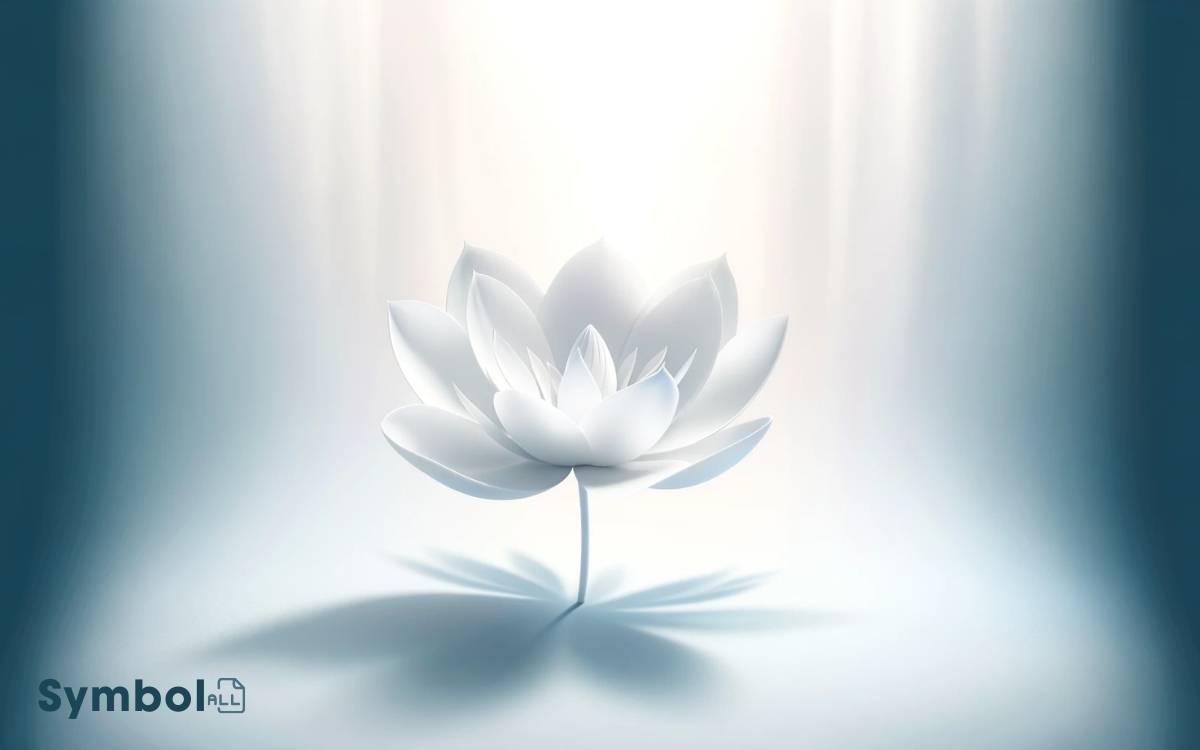What Does a White Flower Symbolize? Purity, Innocence!
White flowers symbolize purity and innocence, a concept rooted in their genetic pathways that inhibit anthocyanin production.
This absence of pigment allows them to reflect all visible light wavelengths, making them stand out in dim light conditions, essential for attracting pollinators.
Beyond their botanical significance, white flowers represent new beginnings and fresh starts, embodying a sense of a blank slate or rebirth.
They’re also a universal symbol for sympathy, conveying condolences with their pure, tranquil presence.
Scientifically, their bloom signals readiness for reproduction, aligning with seasonal shifts. Understanding their layered meanings illustrates a deeper appreciation for these blossoms’ place in various contexts.

Key Takeaways
Purity and Innocence
White flowers often symbolize purity and innocence, reflecting a universal language in floral symbolism that transcends cultural boundaries.
This symbolism is rooted in the inherent characteristics of the color white, which scientifically represents the presence of all visible light wavelengths combined. As a result, it’s perceived as pure and complete.
In the botanical world, white flowers have evolved to attract pollinators through their visibility in dim light, akin to innocence attracting positivity.
Their pigmentation, or rather the lack thereof, results from specific genetic pathways that inhibit the production of anthocyanins, compounds responsible for color in plants.
This genetic specificity adds a layer of rarity and uniqueness to white flowers, further associating them with the pristine and untouched.
Understanding this connection can deepen your appreciation for the symbolic and biological significance of white flowers.
New Beginnings
As you explore the role of white flowers, you’ll find they often symbolize a fresh start, making them a prevalent choice for weddings and marking new beginnings.
Scientifically speaking, their pure color reflects the full spectrum of light, embodying the concept of a blank slate or rebirth.
The renewal of spring, epitomized by the blooming of white flowers, further underscores their significance in symbolizing new life phases.
Symbolic Fresh Start
In the realm of horticultural symbolism, white flowers often represent a fresh start or the inception of a new chapter in one’s life.
This association stems from the inherent properties and biological functions of the color white in the plant kingdom.
White, reflecting all wavelengths of light, symbolizes purity and cleanliness, conditions often sought after in periods of renewal.
In botany, the emergence of white blossoms signals a plant’s readiness for reproduction, mirroring the concept of new beginnings in human contexts.
Moreover, the phenological cycle of many white-flowering plants, initiating their bloom cycle in alignment with seasonal shifts, underscores their role as harbingers of change.
In selecting white flowers, you’re not just choosing a color but embracing a symbol deeply rooted in natural cycles of growth and renewal.
Wedding Floral Choice
Building on the symbolism of new beginnings, opting for white flowers for wedding ceremonies can greatly emphasize the start of a couple’s journey together.
In the context of matrimonial events, white flowers serve not only as decor but as a powerful symbol of purity, unity, and the promise of a fresh start.
Scientifically, the color white reflects all wavelengths of visible light, which can be seen as the representation of all possibilities ahead for the newlyweds.
This choice, steeped in cultural and botanical significance, allows for a nuanced expression of hope and joy.
Choosing specific species like roses, lilies, or peonies further personalizes the message, as each flower carries unique symbolic weight.
Integrating white florals into wedding ceremonies is both a visual and metaphorical affirmation of new beginnings.
Springs Renewed Bloom
Spring heralds the arrival of new life, with white flowers blooming as important symbols of rebirth and rejuvenation across various ecosystems. You’ll observe these transformations keenly in both wild landscapes and cultivated gardens.
The white petals reflect the full spectrum of sunlight, facilitating photosynthesis efficiently under the canopy’s dappled light, a crucial adaptation for early spring bloomers.
| Flower Name | Significance |
|---|---|
| Snowdrop (Galanthus) | Purity, hope, and consolation |
| White Crocus | Youthfulness, cheerfulness |
| Lily of the Valley | Sweetness, humility |
These species exemplify the resilience and adaptability required to thrive in the changing conditions of spring.
Their early emergence isn’t merely a visual delight but a critical ecological function, signaling the reawakening of pollinators and the cyclic renewal inherent in their habitats.
Sympathy and Remembrance
White flowers hold a special significance in conveying sympathy and remembrance, serving as a universal symbol of purity and condolence.
In the language of flowers, known as floriography, each white bloom carries a message of solace and memory, rooted deeply in botanical symbolism and cultural practices.
Scientically, the color white reflects all wavelengths of visible light, which can be interpreted as embodying the full spectrum of emotions experienced during mourning and remembrance.
This spectral property lends white flowers their ethereal appearance, making them ideal for expressions of sympathy.
Additionally, specific varieties, such as lilies and chrysanthemums, are often associated with funerary traditions, their biology and growth cycles symbolizing the cyclical nature of life and the hope for renewal beyond grief.
Reverence and Humility
In the domain of floriography, white flowers also symbolize reverence and humility, embodying these complex emotions through their pure and simple beauty.
These flowers capture the essence of respect and modesty in a manner that resonates deeply within human culture.
Their unassuming appearance is a proof to the subtlety of humility, while their pristine color evokes a sense of reverence.
- Chlorophyll Reduction: The lack of chlorophyll in white petals represents purity, correlating with humility’s unadulterated nature.
- Petals’ Structure: Delicate and unblemished, symbolizing respect and deference.
- Fragrance: Often subtle, signifying the quiet strength of humility.
- Growth Habit: Thriving in both sunlight and shade, illustrating humility’s versatility and reverence’s encompassing nature.
These characteristics combined make white flowers a strong symbol for expressing reverence and humility.
Peace and Tranquility
Often overlooked, white flowers frequently embody the essence of peace and tranquility through their serene appearance and the calming effect they exert on their surroundings.
| Species | Chemical Compounds | Effect on Humans |
|---|---|---|
| Lily | Alkaloids | Reduces anxiety |
| Jasmine | Linalool | Enhances calmness |
| Rose | Geraniol | Promotes relaxation |
White flowers, through their visual purity and the chemical compounds they release, play a significant role in instigating a peaceful atmosphere.
Alkaloids present in lilies, for instance, have been scientifically proven to reduce anxiety, while linalool found in jasmine enhances calmness. Additionally, geraniol emitted by roses is known for its ability to promote relaxation.
This intricate interplay between botanical chemistry and psychological impact underscores the profound tranquility associated with white flowers.
Unconditional Love
When you examine white flowers through the lens of unconditional love, you’ll find they embody pure affection manifestation due to their color’s association with purity and sincerity.
Their presence often symbolizes eternal commitment, serving as a proof to the enduring nature of love that withstands the test of time.
Additionally, these flowers represent innocence in love, highlighting relationships free from pretense or condition, rooted deeply in genuine connection and understanding.
Pure Affection Manifestation
White flowers symbolize pure affection, epitomizing the concept of unconditional love through their pristine and unblemished appearance.
The visual purity of white flowers serves as a metaphor for the purity of emotion that unconditional love represents.
This manifestation of affection, devoid of any selfish intent, aligns with the botanical characteristics of white flowers, which have evolved to signal their availability to pollinators under low-light conditions, thereby ensuring their reproduction and survival.
- Their unblemished petals reflect a commitment to purity and honesty in emotional expression.
- The wide variety of white flowers symbolizes the universal nature of pure affection.
- Their ability to thrive in various conditions mirrors the resilience of unconditional love.
- The simplicity of their color embodies the straightforwardness of genuine affection.
Understanding these aspects provides insight into how white flowers symbolize the depth and purity of unconditional love.
Eternal Commitment Symbol
As symbols of eternal commitment, white flowers embody the essence of unconditional love through their perennial nature and enduring beauty.
Their presence in botanical compositions often signifies a bond that transcends time, rooted deeply in the science of plant genetics and the physiology of perennial growth.
White flowers, through their cyclical blooming patterns, demonstrate resilience and the ability to renew their vows of beauty and allegiance to their surroundings annually.
This metaphorical representation is supported by the study of plant longevity and adaptation mechanisms, which enable these flowers to thrive across seasons, reflecting the steadfast nature of unconditional love.
Essentially, their biological persistence and aesthetic continuity serve as a potent symbol for lifelong dedication, mirroring the human desire for a love that’s both constant and evolving.
Innocence in Love
In the domain of botanical symbolism, white flowers epitomize the purity and simplicity inherent in unconditional love, reflecting a seamless blend of emotional innocence and complex reproductive strategies.
You’ll find that these floral emblems serve as conduits for expressing the most sincere forms of love, untainted by the complexities of human conditions.
- Albedo Effect: The high reflectance of white petals symbolizes clarity in emotions, mirroring the unblemished nature of true love.
- Fragrance Profile: Subtle yet profound, the scents of white flowers suggest a deep, underlying strength within vulnerable innocence.
- Bloom Cycle: Their perennial nature embodies the enduring, ever-renewing quality of love that withstands time’s trials.
- Pollinator Attraction: The strategic coloration attracts specific pollinators, illustrating the selective bonds of pure affection in ecological symbiosis.
Elegance and Simplicity
Elegantly simplistic in their appearance, white flowers symbolize purity and sophistication, effortlessly enhancing any setting with their understated beauty.
In botanical terms, the white pigment, or lack thereof, results from the absence of the pigment chlorophyll, anthocyanins, and other color-imparting compounds, reflecting all wavelengths of visible light.
This scientific phenomenon contributes to their clean, pristine look, making white flowers a symbol of elegance and simplicity.
Horticulturally, they’ve been bred for characteristics like brightness and size, to stand out in minimalistic garden designs or as focal points in floral arrangements.
Their visual simplicity, coupled with the complexity of their cultivation, embodies a balance between natural beauty and human ingenuity.
You’ll find that their aesthetic appeals to a sense of serenity and clarity, perfect for occasions that call for subtlety and grace.
Spiritual Significance
White flowers hold a profound spiritual significance, often symbolizing purity, peace, and renewal across various cultures and religious traditions.
Their universal appeal lies in their ability to convey messages of hope and transcendence beyond the spiritual domain.
- Purity: Scientifically, the color white reflects all wavelengths of visible light without absorption, symbolizing a state of purity and unblemished perfection.
- Peace: In ethology, calm behavior in many species is associated with lighter colors, suggesting a universal peace symbol.
- Renewal: Botanically, white flowers often emerge first in spring, representing new beginnings and the renewal of life.
- Transcendence: Culturally, they’re used in rituals and ceremonies to signify the soul’s journey towards enlightenment, transcending the metaphysical world.
Understanding these aspects enriches one’s appreciation for the spiritual depth these blossoms embody.
Conclusion
To sum up, you’ve discovered that the white flower isn’t just a simple botanical specimen; it’s a marvel of nature’s symbolism.
Through genetic pigmentation and evolutionary adaptation, it embodies purity, new beginnings, and more.
Surprisingly, the coincidence that such diverse meanings ranging from sympathy to unconditional love are encapsulated in one color spectrum highlights nature’s intricate design.
This botanical phenomenon, through its elegant simplicity and complex symbolism, exemplifies how nature intricately weaves emotional and spiritual significance into its tapestry.






